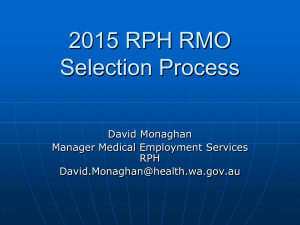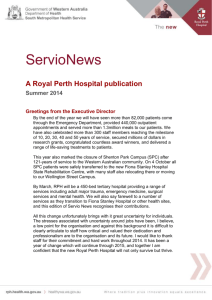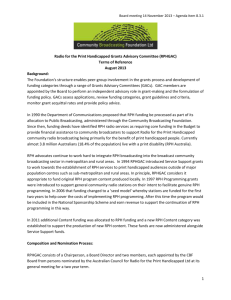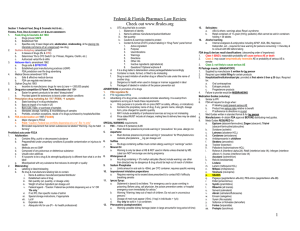Designing Pharmacy Services - American Pharmacists Association
advertisement
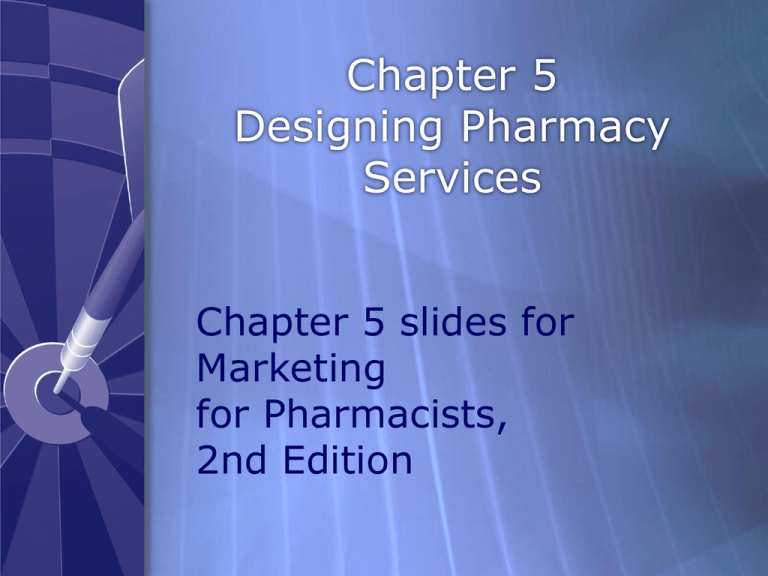
Chapter 5 Designing Pharmacy Services Chapter 5 slides for Marketing for Pharmacists, 2nd Edition Learning Objectives Compare and contrast the production line approach and the empowerment approach to designing and managing pharmacy services. Explain the concept of service scripts and their value in providing excellent pharmacy services. List the steps involved in service recovery. Discuss the purpose of a service blueprint. Identify the key components and the steps involved in building the blueprint. Discuss the main elements of a service audit. Give examples of questions associated with each element. Think about your last job. How would you characterize the service provided? World-class? Distinctive? Journeyman? Available for service? Approaches to Design and Management of Services Production line approach Empowerment approach Production line Top-down design Standardize, simplify, clear division of labor, substitute technology for employees, minimize independent decisions by employees, use employees as interchangeable parts Increase efficiency and speed; lower cost/unit Empowerment Bottom-up design Give employees power, flexibility, and responsibility in their jobs. Give discretion and tools with minimal policies and rules. Empowerment Benefits Adaptable Spontaneous Ability to cope Recovery Costs Harder to manage Less efficient and more expensive Potentially more bad decisions Better approach depends on Basic business strategy Nature of transaction Need of patients Type of employees and managers (see situational leadership) Trade-off between managerial control and employee involvement Planning for Service Performance TIP Good service comes from good planning. Service script Describes a service performance in a written list of actions Service Script Example Service scripts Establish expected actions and responsibilities Standardize procedures Are based upon best methods available Can be used for both production line and empowerment approaches Indian Health Service counseling guidelines 1. What did the doctor tell you the medicine is for? 2. How did the doctor tell you to take the medicine? 3. What did the doctor tell you to expect? Examples of script situations Dispensing error Situation that requires a physician to change a prescribed therapy Nonformulary prescription Prior authorization Nursing administration error Patient complaint about the price of a prescription Hostile customer Drug incompatibility (e.g., intravenous) Physician prescribing error Drug allergy Drug interaction Service mistake (e.g.,overcharge) Negotiation with co-workers Difficult counseling situation Patient with renal/hepatic insufficiency Service recovery (example of a script) Mistakes are inevitable. Mistakes present an opportunity to save or even strengthen a relationship with a customer. Dissatisfied customers will tell between 9 and 16 people about a poor service experience. Repurchase intentions increase from 19% to 54% when complaints are satisfactorily addressed. Steps to service recovery Search out potential for service failures and dissatisfaction. If a failure occurs Apologize. Offer a remedy. Solve the problem immediately. If possible or necessary, offer compensation to customers for their trouble. Service blueprints Service blueprints are flowcharts used to design service operations. They are maps of service processes that permit pharmacists to better see and understand them. They simultaneously depict the process, customer roles, service providers, and supporting services. They break down the service into components and arrange them according to their purpose. Pharmacy Exterior Parking Appearance of Non-pharmacy Departments Arrive at Pharmacy Employee Dress Non-prescription Merchandising Waiting Area Patient Information Brochures Signs Gives Prescription (Rx) to Pharmacy Employee Fills Out Patient Profile Appearance of Rx Labels Appearance of Drug Bill Drug Information Insert Picks Up & Pays for Rx Is Counseled About Rx Presents Bill for Rx and Merchandise (RPh/Tech) Counsels Patient (RPh) Fill Rx (Tech) Check Rx (RPh) Line of Interaction Receives & Checks Rx (RPh/Tech) Greets Customer (RPh/Tech) Profile Reviewed (RPh) Clarification Needed? Yes No Line of Visibility Computer Entry (Tech) Calls MD’s Office(RPh) Ok’d byRPh Drug Interaction or DUR Notification? Line of Internal Interaction Clarification or Change Made with Rx Do not fill Insurance DUR Notification Service Blueprint for Dispensing Services Blueprint advantages Includes patient view Makes process visually explicit Permits cost-benefit trade-offs Service audit (see Table 5-2) Systematic, critical review of the way services are marketed by organizations, examining Marketing orientation New customer marketing Existing customer marketing Internal marketing Service quality Conclusion Design can make the difference between poor and excellent services. Production line and empowerment approaches both can be useful frameworks for providing pharmaceutical services. Service scripts, blueprints, and audits can each help improve the design of pharmacist services. Questions?




